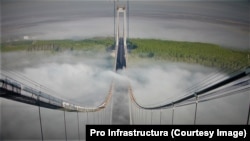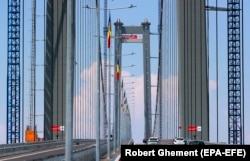The largest suspension bridge in Romania opened in July 2023 to honks from drivers and speeches from politicians. But just months later, the 500 million euro ($527 million) Braila Bridge across the Danube River is beset with problems.
In late October, Romania’s National Road and Infrastructure Administration Company (CNAIR) responded to a query from RFE/RL’s Romanian Service about reports of water seeping into the lining around the bridge’s anchor blocks -- 47-meter-wide chunks of concrete at each end of the structure that keep the massive cable system taut. “This issue was identified by a consulting team, which opened several noncompliance reports,” a CNAIR spokesman wrote.
The water seepage is only the latest problem to hit the bridge.
In August, video emerged of a man pulling out loose bolts from the massive structure with his bare hands, prompting an investigation. CNAIR concluded that 401 bolts of 100,000 in the bridge “were not securely fastened.”
Shortly after its opening, cracks in the surface of the bridge began to appear, some of which have developed into deep fissures. A CNAIR spokesman told local journalists that “we hope that the bridge manufacturer will find and apply the same lasting solution that has worked in other countries because it is not normal for such problems to appear month after month." Trucks ignoring the 7.5 ton weight limit of the bridge during summer months have been blamed for the cracks.
The current leaks in the anchor blocks may be especially problematic due to the work needed to remedy them. "To deal with these seepages, you need to dig parallel to the anchor blocks," a CNAIR official told RFE/RL. "That could weaken the anchoring system of the bridge piers which would lead to an extremely dangerous situation."
Responsibility for repairing the seepage lies “only with the contractors” CNAIR says. The bridge was constructed by the Italian Webuild SpA construction giant, and Japanese firm IHI. A 10-year guarantee was written into the contract.
Webuild did not respond to RFE/RL's requests for comment about the seepage, but engineering specialists say that the solution would likely be to build a new "lining" around the current anchor blocks that would be as watertight as possible. Pumps would then need to be installed to remove any water buildup.
The Braila Bridge spans nearly 2 kilometers, making it one of the largest of its kind in Europe. Situated just north of the eastern city of Braila, the bridge replaced a car ferry service that required around 50 minutes to cross the Danube River. The ferry was vulnerable to storms, and ice floes during harsh winters. Approximately 363 million euros ($383 million) were contributed by the EU to the construction project, which began in December 2018 and cost a total of around half a billion euros.
With its massive scale, and distinctive silhouette it was dubbed Romania’s “Golden Gate” bridge and had been expected to serve around 7,000 vehicles per day.










